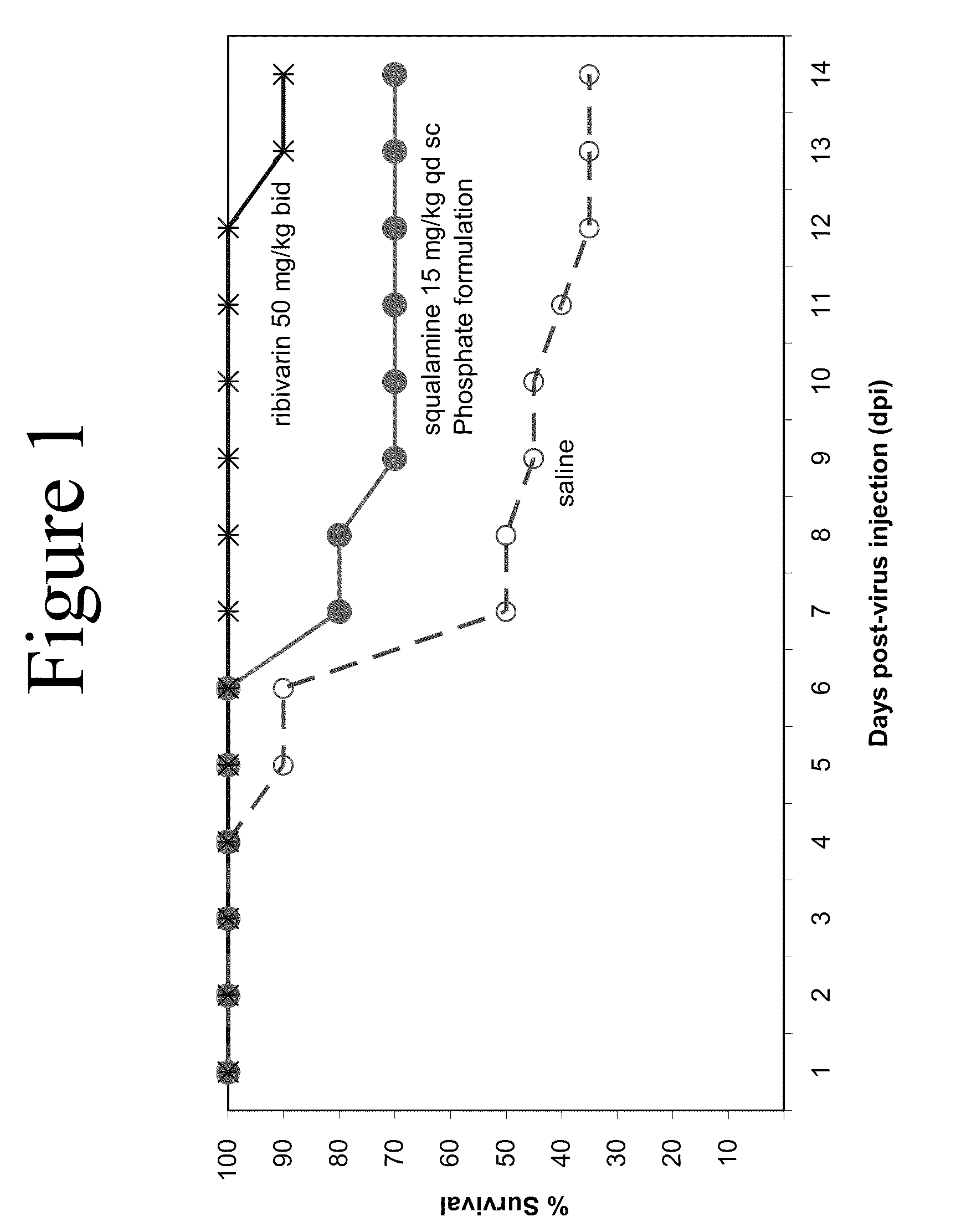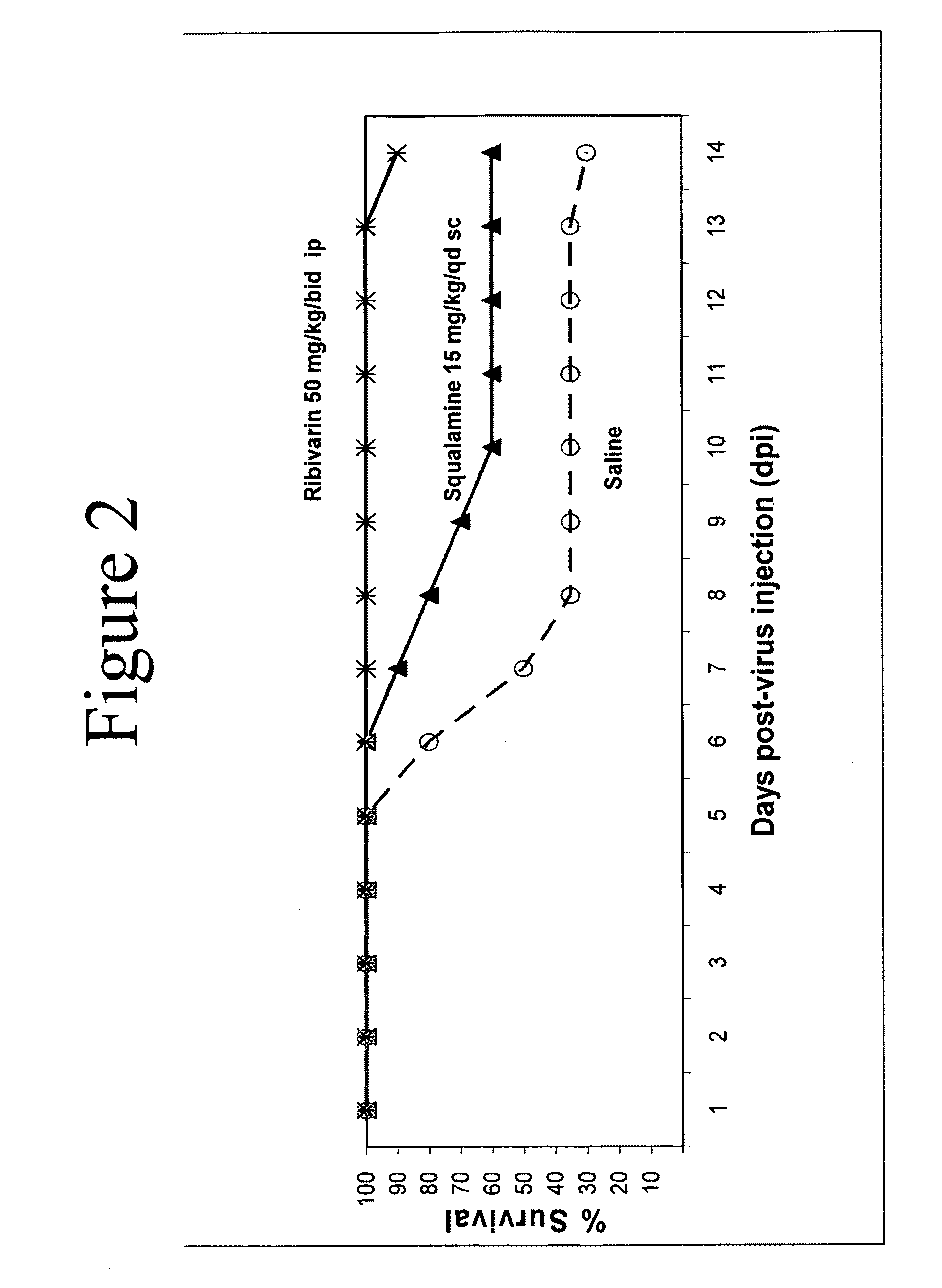Formulations comprising aminosterols
a technology of aminosterols and compositions, applied in the direction of aerosol delivery, inorganic non-active ingredients, metabolic disorders, etc., can solve the problems of no published data describe or support the efficacy of squalamine in treating, and affect the effect of squalamine local membrane damag
- Summary
- Abstract
- Description
- Claims
- Application Information
AI Technical Summary
Benefits of technology
Problems solved by technology
Method used
Image
Examples
example 1
Striking Insolubility of Squalamine in the Presence of Inorganic Phosphate and Polyphosphate, but not with Other Common Inorganic Anions
[0179]The solubility of various squalamine salts was examined to establish a salt form that was partially soluble in water.
[0180]A solution of squalamine lactate was prepared in water to a concentration of 10 mg / ml. To 0.1 ml of this solution, 1 volume of a 0.1M solution of various organic and inorganic anions was added. Insolubility of the salt form was scored by the change in the solution from clear / transparent to turbid / cloudy. The results are shown in Table 1, below.
TABLE 1SaltTurbiditySodium phosphate, pH 7.4yesPotassium phosphate, pH 7.4yesMagnesium phosphate, pH 7.4yesSodium pyrophosphateyesSodium triphosphateyesSodium acetatenoSodium chloridenoSodium lactatenoSodium gluconatenoSodium sulfatenoSodium pyruvatenoSodium citratenoSodium mesylatenoSodium trifuoracetatenoSodium carbonatenoSodium fluoridenoSodium iodatenoSodium nitratenoGlucose 6-ph...
example 2
[0182]This example evaluated whether an organic phosphate ester could complex with squalamine to generate a weakly soluble salt. Certain organic phosphate esters, such as glycerol-2-phosphate appear to form weakly soluble salts with squalamine, while others such as Glucose-6-phosphate do not. This difference is likely due to the degree of steric hindrance imposed by the organic moiety on electrostatic interactions between the cationic amino groups of the polyamine tail of squalamine and the anionic oxygens of the phosphate.
[0183]To determine the approximate molar ratios of squalamine and phosphate that comprise the weakly soluble salt, 50 mg of squalamine (“active”) (80 micromoles) lyophilized in vials was dissolved in 3 ml of water. Sodium phosphate (1M, pH 7.7) was added to each vial to 10 mM, 25 mM, 35 mM, and 50 mM, corresponding to 30, 75, 105, and 150 micromoles Phosphate. Samples containing 30 and 75 micromoles of phosphate were milky and turbid, while those containing 105 an...
example 3
[0185]To determine the approximate molar ratios of squalamine and pyrophosphate that comprise the weakly soluble pyrophosphate salt, 50 mg of squalamine (“active”) (80 micromoles) lyophilized in vials was dissolved in 3 ml of water. Sodium pyrophosphate (1M, pH 7.7) was added to each vial to 1 mM, 2 mM, 4 mM, 6 mM, 10 mM, 25 mM, 35 mM, and 50 mM, corresponding to 3, 6, 12, 24, 30, 75, 105, and 150 micromoles Phosphate. Samples containing 3, 6, 12, 24 and 30 micromoles of pyrophosphate were milky, while those containing 75, 105 and 150 formed heavy flocculent precipitates. Thus, the poorly soluble complex formed between 30 and 75 micromoles of pyrophosphate.
[0186]From this example it can be concluded that the weakly soluble salt between pyrophosphate and squalamine a 1:2 complex between the pyrophosphate anion and two squalamine molecules, as shown in the structure below:
[0187]Preparation of Squalamine Phosphate: Squalamine Phosphate can be prepared simply by adding a soluble phospha...
PUM
| Property | Measurement | Unit |
|---|---|---|
| particle size | aaaaa | aaaaa |
| concentrations | aaaaa | aaaaa |
| concentration | aaaaa | aaaaa |
Abstract
Description
Claims
Application Information
 Login to View More
Login to View More - R&D
- Intellectual Property
- Life Sciences
- Materials
- Tech Scout
- Unparalleled Data Quality
- Higher Quality Content
- 60% Fewer Hallucinations
Browse by: Latest US Patents, China's latest patents, Technical Efficacy Thesaurus, Application Domain, Technology Topic, Popular Technical Reports.
© 2025 PatSnap. All rights reserved.Legal|Privacy policy|Modern Slavery Act Transparency Statement|Sitemap|About US| Contact US: help@patsnap.com



